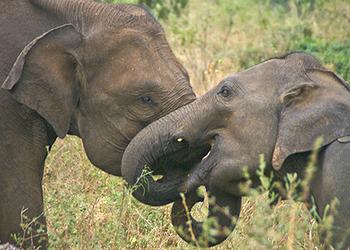
BANGKOK, Thailand, February 24, 2014 (ENS) – Asian elephants reassure other elephants in distress with physical touches and vocalizations, finds a study that provides the first evidence of consolation in elephants.
“Humans are unique in many ways, but not in as many ways as we once thought,” said lead author Joshua Plotnik, a lecturer in conservation biology at Mahidol University in Bangkok.
“For centuries, people have observed that elephants seem to be highly intelligent and empathic animals, but as scientists we need to actually test it,” said Plotnik, who began the research as a graduate student of psychology at Emory University in Georgia.
Consolation behavior is rare in the animal kingdom, with empirical evidence previously provided only for the great apes, canines and certain birds in the crow family.
The current study focused on a group of 26 captive Asian elephants living on about 30 acres at an elephant camp in northern Thailand. For nearly a year, the researchers observed and recorded incidences when an elephant displayed a stress reaction and the responses from other nearby elephants.
The initial stress responses came from stimuli such as a dog walking past, a snake or other potentially dangerous animal rustling the grass, or the presence of another, unfriendly elephant.
“When an elephant gets spooked, its ears go out, its tail stands erect or curls out, and it may emit a low-frequency rumble, trumpet and roar to signal its distress,” explained Plotnik.

The study found that nearby elephants “affiliated significantly more with a distressed individual through directed, physical contact following a stress event than during control periods.”
A nearby elephant would go to the side of the distressed animal and use its trunk to gently touch its face, or put its trunk in the other animal’s mouth.
The gesture of putting their trunks in each other’s mouths is almost like an elephant handshake or hug, Plotnik said. “It’s a very vulnerable position to put yourself in, because you could get bitten. It may be sending a signal of, ‘I’m here to help you, not hurt you.'”
The responding elephants also showed a tendency to vocalize.
“The vocalization I heard most often following a distress event was a high, chirping sound,” Plotnik said. “I’ve never heard that vocalization when elephants are alone. It may be a signal like, ‘Shshhh, it’s okay,’ the sort of sounds a human adult might make to reassure a baby.”
Elephants frequently responded to the distress signals of other elephants by adopting a similar body or emotional state, a phenomenon known as “emotional contagion,” which may be related to empathy.
Groups of nearby elephants also were more likely to bunch together, or make physical contact with each other.
As an example of emotional contagion in humans, Plotnik described a couple watching a movie. “When a character on the screen is scared, the hearts of the couple watching might race and they might move a bit closer and hold each others hands.”
“With their strong social bonds, it’s not surprising that elephants show concern for others,” said co-author Frans de Waal, an Emory professor of psychology and director of Living Links at Emory’s Yerkes National Primate Research Center.
“This study demonstrates that elephants get distressed when they see others in distress, reaching out to calm them down, not unlike the way chimpanzees or humans embrace someone who is upset,” said de Waal.
While Plotnik was still at Emory, he and de Waal provided evidence that elephants can recognize themselves in a mirror, a test of self-awareness passed only by some apes, dolphins and magpies. Elephants also showed they can solve problems cooperatively.
Decades ago, de Waal was one of the first to provide evidence of reconciliation in non-human primates, showing how chimpanzees make up with one another after a fight.
De Waal’s research also demonstrated consolation behavior. After two chimpanzees fight, a third individual may come over and console the distressed loser of the battle with an embrace.
Reconciliation behaviors have since been demonstrated in many more species than those that have shown the capacity for consolation.
“One hypothesis for why we don’t see consolation as often is that more complex cognition may underlie it,” Plotnik said. “Rather than just functioning as a way to maintain or repair relationships in a social group, consolation may also require empathy. The ability to put yourself emotionally into someone else’s shoes.”
The current elephant study’s limitations include the fact that it was restricted to captive animals. “This study is a first step,” Plotnik said. “I would like to see this consolation capacity demonstrated in wild populations as well.”
Wild populations of elephants, however, are becoming increasingly scarce. Both Asian elephants and African elephants are endangered.
Plotnik is also the founder and CEO of Think Elephants International, a nonprofit based in New York and focused on practicing science in the field, and teaching it in classrooms in Thailand and the United States. Through research on the intelligence of elephants and other animals, Plotnik says the organization hopes to better inform conservation practice in the wild to serve the needs of local human populations and the needs of animals.
“I really believe that to save elephants and other endangered species, we must educate children about them,” he said. “Part of our Think Elephants International curriculum is getting kids directly involved in the research we do, so they learn first-hand about these amazing animals. Elephants are incredibly majestic and there is still so much to learn about their behavior and intelligence.”
The study will be published in the peer-reviewed journal “PeerJ.” All works published in “PeerJ” are Open Access and published using a Creative Commons license. Everything is immediately available to read, download, redistribute, include in databases and otherwise use, without cost to anyone, anywhere, subject only to the condition that the original authors and source are attributed.
Copyright Environment News Service (ENS) 2014. All rights reserved.
